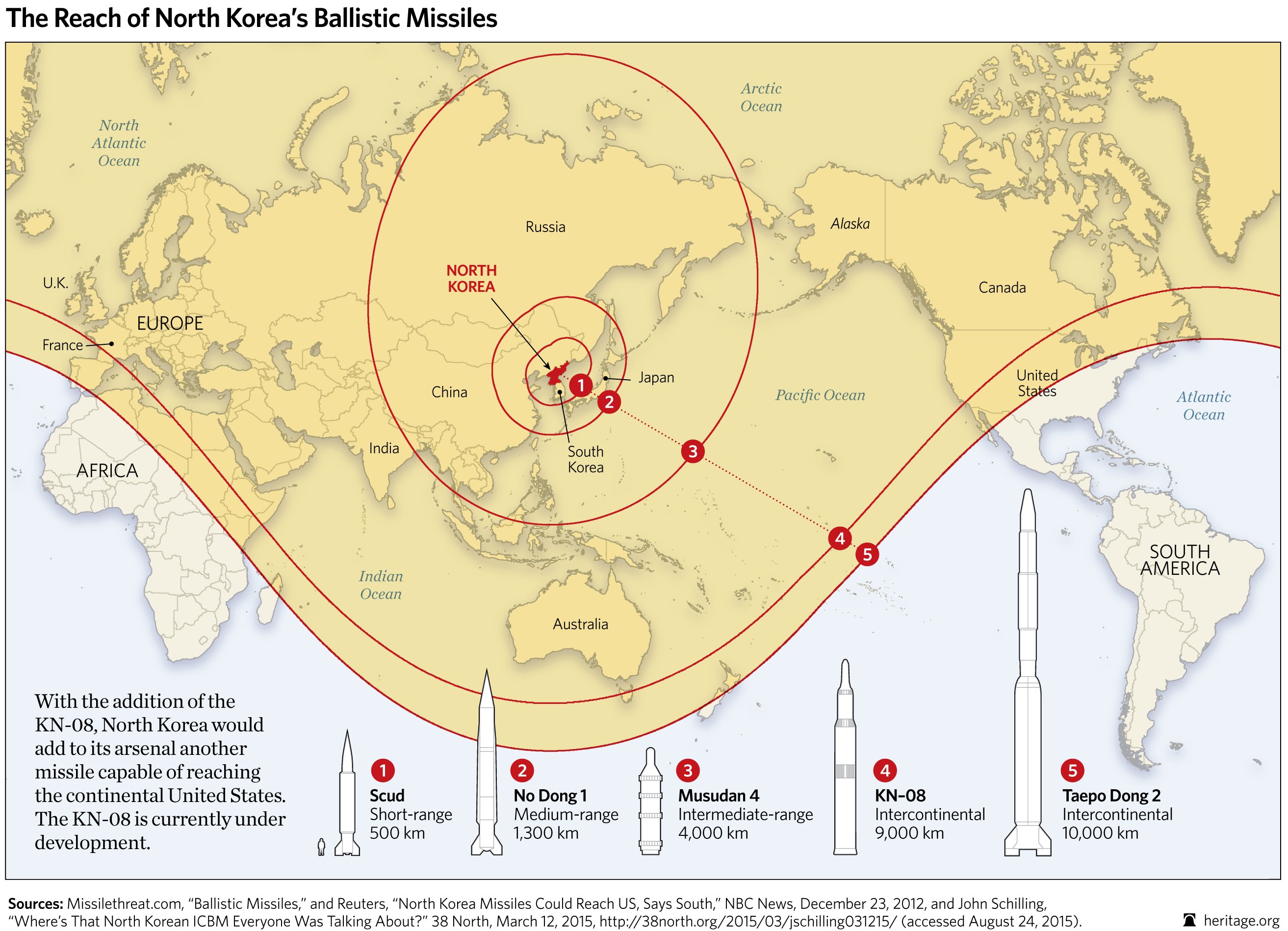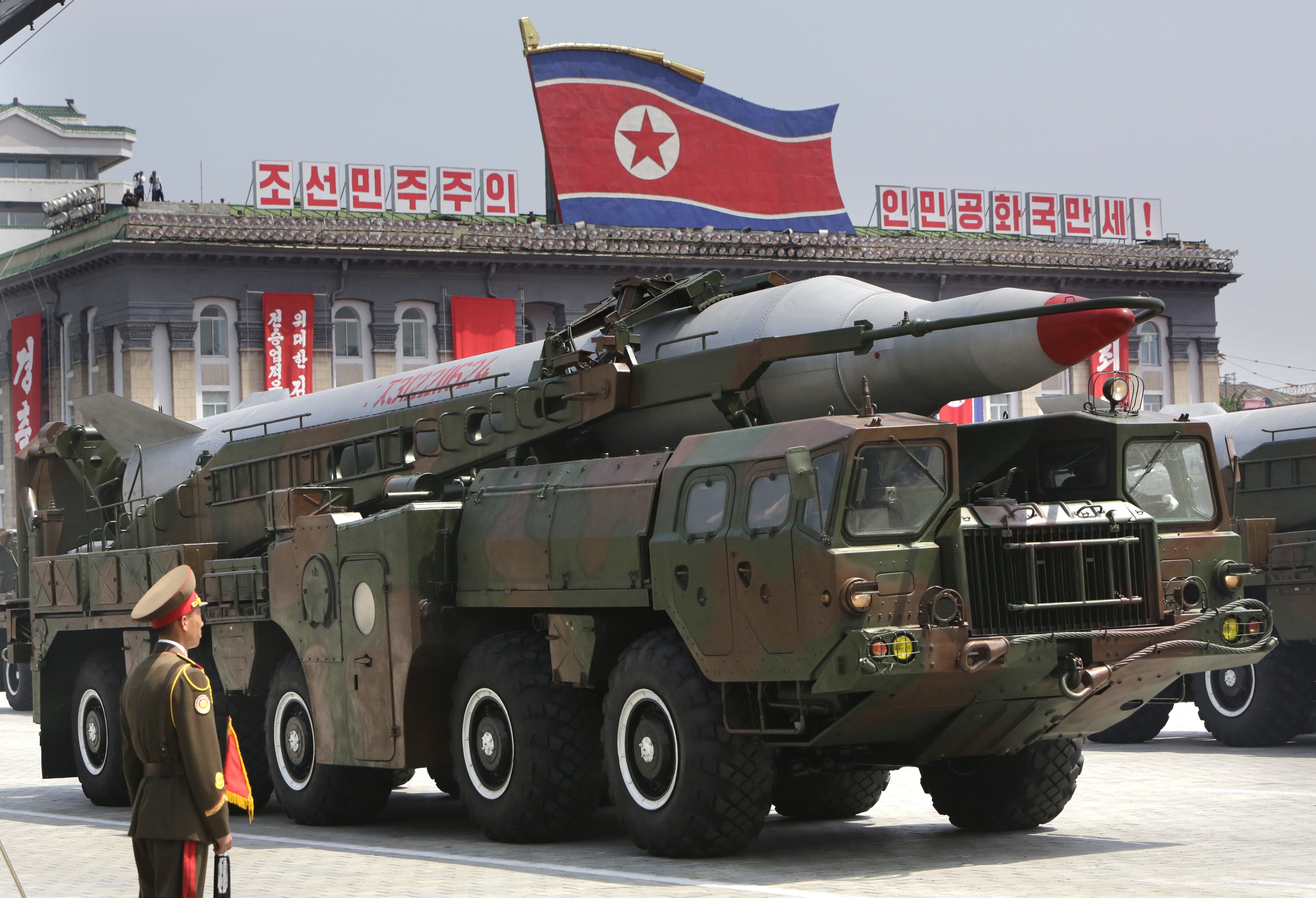North Korea now has a range of ballistic missiles that are thought to be capable of hitting both the US mainland and American interests throughout the Pacific, The Heritage Foundation reports in its 2016 Index of US Military Strength.
The annual report examines the strength of the US military, and also takes into account potential rising threats to the US and its allies from across the world. According to Heritage, the threat from the nuclear-armed, anti-American authoritarian state will only get more complicated in 2016.
Pyongyang has continued to develop of a range of ballistic missiles, at the same time the regime pushes to create miniaturized nuclear warheads that can be placed atop those missiles. If constructed, these warheads would allow Pyongyang to hypothetically launch long-range nuclear strikes, as this graphic from Heritage demonstrates:
 The Heritage Foundation 2016 Index of U.S. Military Strength
The Heritage Foundation 2016 Index of U.S. Military Strength
“North Korea has an extensive ballistic missile force that could strike South Korea, Japan, and US military bases in Asia,” the report states. “Pyongyang has deployed at least 400 Scud short-range tactical ballistic missiles, 300 No-Dong medium-range missiles, and 100 to 200 Musudan intermediate-range ballistic missiles.”
The longest-range missile, the Taepo Dong 2, is still in development. However, if deployed, the missile is believed to be nuclear capable if North Korea ever succeeded in miniaturizing nuclear warheads.
The most serious of North Korea’s missile threats comes from the country’s KN-08 missile. The KN-08 is a road-mobile intercontinental missile, meaning Pyongyang can move the launch system throughout the country. In contrast, other long-range missiles must be fired from stationary launch pads.
“It’s the relocatable target set that really impedes our ability to find, fix, and finish the threat,” Adm. Bill Gortney, the commander of NORAD, told reporters in April 2015. “And as the targets move around and we if don’t have the persistent stare and persistent [intelligence, surveillance, and reconnaissance] that we do not have over North Korea at this time, that relocatable nature makes it very difficult for us to counter it.”
Heritage notes that Gortney also said in April 2015 that the KN-08 “is operational today. Our assessment is that they have the ability to put a nuclear weapon on a KN-08 and shoot it at the homeland.”
A missile is carried by a military vehicle during a parade to commemorate the 60th anniversary of the signing of a truce in the 1950-1953 Korean War, at Kim Il-sung Square in Pyongyang July 27, 2013.
 REUTERS/Jason Lee
REUTERS/Jason Lee
In an article for Johns Hopkins University’s 38 North, North Korea experts John Schilling and Henry Kan estimate that the KN-08 would have a maximum range of 5,600 miles, making the missile capable of hitting the West Coast of the continental US.
The weapon, however, is unlikely to have the accuracy required for precision targeting on large US cities. And although the Pyongyang may soon develop the capability needed to launch missiles towards the US, it’s still possible that it wouldn’t be able to evade existing US missile defenses.
“Should [a missile] get airborne and come at us, I’m confident we would be able to knock it down,” Gortney told reporters.


 8 ways Kim Jong-Un has blindsided the US
8 ways Kim Jong-Un has blindsided the US North Korea launches missiles into Japan Sea because it’s just that time again
North Korea launches missiles into Japan Sea because it’s just that time again North Korea launches missiles over Japan, activating J-Alert warning system
North Korea launches missiles over Japan, activating J-Alert warning system America admits it has no idea what Kim Jong-un is doing
America admits it has no idea what Kim Jong-un is doing Close call – Passenger plane passed through North Korean missile trajectory just 6 minutes later
Close call – Passenger plane passed through North Korean missile trajectory just 6 minutes later McDonald’s new Happy Meals offer up cute and practical Sanrio lifestyle goods
McDonald’s new Happy Meals offer up cute and practical Sanrio lifestyle goods All-you-can-drink Starbucks and amazing views part of Tokyo’s new 170 meter-high sky lounge
All-you-can-drink Starbucks and amazing views part of Tokyo’s new 170 meter-high sky lounge More foreign tourists than ever before in history visited Japan last month
More foreign tourists than ever before in history visited Japan last month Starbucks reopens at Shibuya Scramble Crossing with new look and design concept
Starbucks reopens at Shibuya Scramble Crossing with new look and design concept The oldest tunnel in Japan is believed to be haunted, and strange things happen when we go there
The oldest tunnel in Japan is believed to be haunted, and strange things happen when we go there Flying Totoro appears in new Studio Ghibli x Foxfire collection
Flying Totoro appears in new Studio Ghibli x Foxfire collection Is the new Shinkansen Train Desk ticket worth it?
Is the new Shinkansen Train Desk ticket worth it? What happens to Cup Noodle Mystery Meat when you cook it in a rice cooker?
What happens to Cup Noodle Mystery Meat when you cook it in a rice cooker? Beautiful Sailor Moon manhole cover coasters being given out for free by Tokyo tourist center
Beautiful Sailor Moon manhole cover coasters being given out for free by Tokyo tourist center A visit to the best UFO catcher arcade in the universe!
A visit to the best UFO catcher arcade in the universe! Disney princesses get official manga makeovers for Manga Princess Cafe opening in Tokyo
Disney princesses get official manga makeovers for Manga Princess Cafe opening in Tokyo We try out “Chan Ramen”, an underground type of ramen popular in the ramen community
We try out “Chan Ramen”, an underground type of ramen popular in the ramen community Beautiful new Final Fantasy T-shirt collection on the way from Uniqlo【Photos】
Beautiful new Final Fantasy T-shirt collection on the way from Uniqlo【Photos】 Foreign English teachers in Japan pick their favorite Japanese-language phrases【Survey】
Foreign English teachers in Japan pick their favorite Japanese-language phrases【Survey】 There’s a park inside Japan where you can also see Japan inside the park
There’s a park inside Japan where you can also see Japan inside the park Japanese convenience store packs a whole bento into an onigiri rice ball
Japanese convenience store packs a whole bento into an onigiri rice ball Studio Ghibli releases Kiki’s Delivery Service chocolate cake pouches in Japan
Studio Ghibli releases Kiki’s Delivery Service chocolate cake pouches in Japan Japan’s bone-breaking and record-breaking roller coaster is permanently shutting down
Japan’s bone-breaking and record-breaking roller coaster is permanently shutting down New definition of “Japanese whiskey” goes into effect to prevent fakes from fooling overseas buyers
New definition of “Japanese whiskey” goes into effect to prevent fakes from fooling overseas buyers Foreign passenger shoves conductor on one of the last full runs for Japan’s Thunderbird train
Foreign passenger shoves conductor on one of the last full runs for Japan’s Thunderbird train Our Japanese reporter visits Costco in the U.S., finds super American and very Japanese things
Our Japanese reporter visits Costco in the U.S., finds super American and very Japanese things Kyoto bans tourists from geisha alleys in Gion, with fines for those who don’t follow rules
Kyoto bans tourists from geisha alleys in Gion, with fines for those who don’t follow rules Studio Ghibli unveils Mother’s Day gift set that captures the love in My Neighbour Totoro
Studio Ghibli unveils Mother’s Day gift set that captures the love in My Neighbour Totoro Domino’s Japan now sells…pizza ears?
Domino’s Japan now sells…pizza ears? New Japanese KitKat flavour stars Sanrio characters, including Hello Kitty
New Japanese KitKat flavour stars Sanrio characters, including Hello Kitty Sales of Japan’s most convenient train ticket/shopping payment cards suspended indefinitely
Sales of Japan’s most convenient train ticket/shopping payment cards suspended indefinitely Sold-out Studio Ghibli desktop humidifiers are back so Totoro can help you through the dry season
Sold-out Studio Ghibli desktop humidifiers are back so Totoro can help you through the dry season Japanese government to make first change to romanization spelling rules since the 1950s
Japanese government to make first change to romanization spelling rules since the 1950s Ghibli founders Toshio Suzuki and Hayao Miyazaki contribute to Japanese whisky Totoro label design
Ghibli founders Toshio Suzuki and Hayao Miyazaki contribute to Japanese whisky Totoro label design Doraemon found buried at sea as scene from 1993 anime becomes real life【Photos】
Doraemon found buried at sea as scene from 1993 anime becomes real life【Photos】 Tokyo’s most famous Starbucks is closed
Tokyo’s most famous Starbucks is closed One Piece characters’ nationalities revealed, but fans have mixed opinions
One Piece characters’ nationalities revealed, but fans have mixed opinions We asked a Uniqlo employee what four things we should buy and their suggestions didn’t disappoint
We asked a Uniqlo employee what four things we should buy and their suggestions didn’t disappoint Princesses, fruits, and blacksmiths: Study reveals the 30 most unusual family names in Japan
Princesses, fruits, and blacksmiths: Study reveals the 30 most unusual family names in Japan Studio Ghibli’s new desktop Howl’s Moving Castle will take your stationery on an adventure
Studio Ghibli’s new desktop Howl’s Moving Castle will take your stationery on an adventure North Korea fires new missile over Japan, residents woken by government warning systems
North Korea fires new missile over Japan, residents woken by government warning systems The power of fast food: Supreme Leader Kim Jong-un wants McDonald’s to invest in North Korea
The power of fast food: Supreme Leader Kim Jong-un wants McDonald’s to invest in North Korea Hackers to Gundam: 5 rumors about failed North Korean missile launch surface on Japanese Internet
Hackers to Gundam: 5 rumors about failed North Korean missile launch surface on Japanese Internet Here’s the military exercise that has North Korea freaking out
Here’s the military exercise that has North Korea freaking out North Korea-U.S. tensions spark interest in Japanese government’s J-Alert warning system
North Korea-U.S. tensions spark interest in Japanese government’s J-Alert warning system Wait, did North Korea really just call South Korea’s president a “blabbering peasant woman”?
Wait, did North Korea really just call South Korea’s president a “blabbering peasant woman”? Kim Jong-un’s “little red book” of quotes is the worst joke book you can buy for 500 yen
Kim Jong-un’s “little red book” of quotes is the worst joke book you can buy for 500 yen North Korea shows military prowess by bludgeoning a wide range of ceramics【Video】
North Korea shows military prowess by bludgeoning a wide range of ceramics【Video】 Is North Korea really forcing its young men to get Kim Jong-un’s haircut? Probably not…
Is North Korea really forcing its young men to get Kim Jong-un’s haircut? Probably not… The latest spat between the two Koreas took a really bizarre turn
The latest spat between the two Koreas took a really bizarre turn North Korea missile alert manga produced by Japanese government office
North Korea missile alert manga produced by Japanese government office The dirty reason China can’t always tell North Korea what to do
The dirty reason China can’t always tell North Korea what to do Typhoon alert goes off on train commuters’ phones, tourists mistake it for Godzilla attack
Typhoon alert goes off on train commuters’ phones, tourists mistake it for Godzilla attack Selfie love shown between South and North Korean gymnasts
Selfie love shown between South and North Korean gymnasts Japan’s Kanji of the Year revealed, reflects both the good and the bad of 2022
Japan’s Kanji of the Year revealed, reflects both the good and the bad of 2022 Hokkaido company to start balloon ride service to the stratosphere
Hokkaido company to start balloon ride service to the stratosphere
Leave a Reply